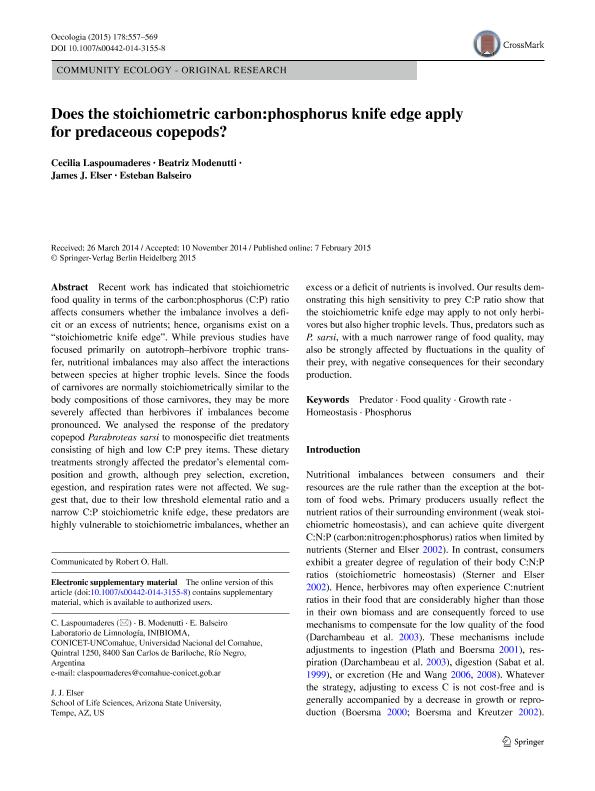Mostrar el registro sencillo del ítem
dc.contributor.author
Laspoumaderes, Cecilia

dc.contributor.author
Modenutti, Beatriz Estela

dc.contributor.author
Elser, James J.
dc.contributor.author
Balseiro, Esteban Gabriel

dc.date.available
2018-05-09T14:43:24Z
dc.date.issued
2015-06-07
dc.identifier.citation
Laspoumaderes, Cecilia; Modenutti, Beatriz Estela; Elser, James J.; Balseiro, Esteban Gabriel; Does the stoichiometric carbon:phosphorus knife edge apply for predaceous copepods?; Springer; Oecologia; 178; 2; 7-6-2015; 557-569
dc.identifier.issn
0029-8549
dc.identifier.uri
http://hdl.handle.net/11336/44580
dc.description.abstract
Recent work has indicated that stoichiometric food quality in terms of the carbon:phosphorus (C:P) ratio affects consumers whether the imbalance involves a deficit or an excess of nutrients; hence, organisms exist on a “stoichiometric knife edge”. While previous studies have focused primarily on autotroph–herbivore trophic transfer, nutritional imbalances may also affect the interactions between species at higher trophic levels. Since the foods of carnivores are normally stoichiometrically similar to the body compositions of those carnivores, they may be more severely affected than herbivores if imbalances become pronounced. We analysed the response of the predatory copepod Parabroteas sarsi to monospecific diet treatments consisting of high and low C:P prey items. These dietary treatments strongly affected the predator’s elemental composition and growth, although prey selection, excretion, egestion, and respiration rates were not affected. We suggest that, due to their low threshold elemental ratio and a narrow C:P stoichiometric knife edge, these predators are highly vulnerable to stoichiometric imbalances, whether an excess or a deficit of nutrients is involved. Our results demonstrating this high sensitivity to prey C:P ratio show that the stoichiometric knife edge may apply to not only herbivores but also higher trophic levels. Thus, predators such as P. sarsi, with a much narrower range of food quality, may also be strongly affected by fluctuations in the quality of their prey, with negative consequences for their secondary production.
dc.format
application/pdf
dc.language.iso
eng
dc.publisher
Springer

dc.rights
info:eu-repo/semantics/openAccess
dc.rights.uri
https://creativecommons.org/licenses/by-nc-sa/2.5/ar/
dc.subject
EstequiometrÍA Ecológica
dc.subject
Redes Tróficas
dc.subject
Calidad de Alimento
dc.subject
Homeostasis
dc.subject
Fósforo
dc.subject.classification
Otras Ciencias Biológicas

dc.subject.classification
Ciencias Biológicas

dc.subject.classification
CIENCIAS NATURALES Y EXACTAS

dc.title
Does the stoichiometric carbon:phosphorus knife edge apply for predaceous copepods?
dc.type
info:eu-repo/semantics/article
dc.type
info:ar-repo/semantics/artículo
dc.type
info:eu-repo/semantics/publishedVersion
dc.date.updated
2018-04-09T16:57:39Z
dc.journal.volume
178
dc.journal.number
2
dc.journal.pagination
557-569
dc.journal.pais
Alemania

dc.journal.ciudad
Berlín
dc.description.fil
Fil: Laspoumaderes, Cecilia. Consejo Nacional de Investigaciones Científicas y Técnicas. Centro Científico Tecnológico Conicet - Patagonia Norte. Instituto de Investigaciones en Biodiversidad y Medioambiente. Universidad Nacional del Comahue. Centro Regional Universidad Bariloche. Instituto de Investigaciones en Biodiversidad y Medioambiente; Argentina
dc.description.fil
Fil: Modenutti, Beatriz Estela. Consejo Nacional de Investigaciones Científicas y Técnicas. Centro Científico Tecnológico Conicet - Patagonia Norte. Instituto de Investigaciones en Biodiversidad y Medioambiente. Universidad Nacional del Comahue. Centro Regional Universidad Bariloche. Instituto de Investigaciones en Biodiversidad y Medioambiente; Argentina
dc.description.fil
Fil: Elser, James J.. Arizona State University; Estados Unidos
dc.description.fil
Fil: Balseiro, Esteban Gabriel. Consejo Nacional de Investigaciones Científicas y Técnicas. Centro Científico Tecnológico Conicet - Patagonia Norte. Instituto de Investigaciones en Biodiversidad y Medioambiente. Universidad Nacional del Comahue. Centro Regional Universidad Bariloche. Instituto de Investigaciones en Biodiversidad y Medioambiente; Argentina
dc.journal.title
Oecologia

dc.relation.alternativeid
info:eu-repo/semantics/altIdentifier/doi/http://dx.doi.org/10.1007/s00442-014-3155-8
dc.relation.alternativeid
info:eu-repo/semantics/altIdentifier/url/https://link.springer.com/article/10.1007%2Fs00442-014-3155-8
Archivos asociados
